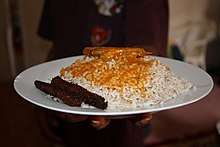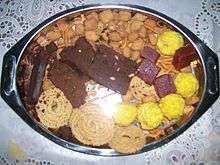Culture of Goan Catholics
The Culture of Goan Catholics is a blend of Portuguese and Indian cultures. After the Portuguese arrived Goa in 1510, they adopted the Portuguese culture but retained their Hindu caste system and few other customs and traditions. Contemporary Goan Catholic culture can be best described as an increasingly anglicised Indo-Latin culture.
Cuisine


Their curries use a lot of coconut, coconut oil and curry leaves while chili peppers, spices and vinegar are also used. Fish curry and rice (Xit kodi in Konkani) forms the staple food of the community. Goan Catholic cuisine has distinct Portuguese influence as can be seen in Sorpotel, a pork dish often served with Sannas (idli fluffed with toddy or yeast) as the Pièce de résistance at wedding dinners and Christmas dinner, while Chouriço (pork sausage), Goa Sausage Risotto, Vindaloo, Aad Maas (pork ribs), Assado de Leitoã or Dukra Roast Maas (roasted pork) and Gaye Roast Maas (roasted beef) are also popular. Goan Catholics mix pork blood and other parts in most of their pork delicacies as can be seen from Pork Bafad. Xacuti (pronounced [shakuti]) is dish originally from Goa prepared with either mutton, pork or chicken.[1] Canja de galinha and Chicken Cafriel are well-known chicken dishes. Vindaloo is another Catholic Goan dish often served during special occasions.Croquettes, beef cutlets and beef potato chops are common snacks. Roast beef and beef tongue are popular entrees at Goan celebrations.
The traditional Nalachi kodi, (literally coconut curry) is a curry made with coconut juice is quite popular. The Goan fish curries and prawn curry are known for their taste and renowned in the whole of coastal India while fried fish dishin their style is well known. Solantule kodi, a spicy coconut and kokum curry is also popular, Ambotik (a sour curry dish) and the Girem-Mirem (a spicy curry, which uses jeera and other spices) are prepared with either fish or meat. Chamuças is a Goan derivative of samosa, which is usually filled with beef or pork is well known snack.[2] The traditional Mol De Peixe (Fish pickle) and Balchão (prawn pickle sauce, originally from Macau) are popular.
Khatkhate, a vegetable with at least 6 vegetables stew is popular. Filoz, a type of pancake, is also popular. Tondak (Beans combined with cashewnuts) is also very popular. Caldo verde is a popular soup. The Cashewnut laddus, Khaje, Revdyo, Peda, Tizan, Godshem, Puran Poli and Sakhar Bhat are well known sweet dishes. The Gulumba, a sweet and sour jam is very popular. Halwas like the Dali kapa (Halwa made of red gram), Cashewnut Halwa, Coconut Halwa, Pumpkin Halwa etc. are popular among Goan Catholics.
Kuswar is a term often used to mention a set of unique Christmas goodies which are part of the cuisine of the Goan Catholic community There are as many as 22 different traditional recipes that form this distinct flavour of Christmas celebration in Goa.
Names and surnames
Bilingual names, having variants in both Konkani and English, like Pedru (Peter) and Mâri (Mary) are common among Goan Catholics. Another popular naming convention uses English names, like Kenneth and Sanferd, that have no Konkani variants. European names such as Mario and Andrea are popular and so are Indian names like Rahul and Anita. Portuguese surnames like Rodrigues and Carvalho, are used abundantly among Goan Catholics due to the former Portuguese colonationization of Goa. Some Goan Catholics still have records of their original Goud Saraswat Brahmin surnames such as Prabhu, Kamat, Pai, and Shenoy.[3]
| Goan Catholic variant | English variant | Meaning | Sex |
|---|---|---|---|
| Anton | Anthony | Flower | Male |
| Lorso | Lawrence | Someone from Laurentum | Male |
| Kenneth | Kenneth | Born of fire | Male |
| Pedru | Peter | Stone | Male |
| Nikel | Nicholas | Victory of the people | Male |
| Šilest | Sylvester | Wooded | Male |
| Zuãuñ | John | God is gracious | Male |
| Zoze | Joseph | The Lord will add | Male |
| Source: English-konkani Dictionary[4] |
Language and literature
Goan Catholics have strong feelings towards the Konkani language, which is often venerated in literature, and in particular to Romi Konkani. It has historically been, and to large extent still is, central to the Goan Catholic identity. They speak Konkani, which is an Indo-Aryan language, belonging to the Indo-European family of languages, spoken predominantly on the west coast of India. The Konkani spoken by Goan Catholics has a larger infusion of words of Portuguese origin as compared to the Konkani spoken by other communities. The number of Goan Catholics that can speak Portuguese is dwindling and increasing numbers of Goan Catholics speak English as their first language.
Traditions and festivals
Goan Catholics have retained their Hindu caste system and customs regarding marriage.
- The soirik or the (betrothal)[5] and mudi (engagement) ceremony.[6] Indian traditions that still persist include adorning the bride with the saddo (red dress or sari), which is to be worn on the first day after the marriage, it is also the name of the ceremony of cutting and sewing the dress[7]
- The chuddo (ceremony during which bangles are worn by the bride),[8][9]
- The ros' (anointing) ceremony, conducted one or two days before the wedding, involves the parents, relatives and friends blessings on the bride and groom, who are anointed with coconut milk.[10] bhuim jevonn (ritual meal in honour of the ancestors) or bikariam che jevonn (meal for the poor/beggars),[11] the
- Template:Oupsoon (giving away the bride formally by the father or the guardian of the bride),
- Template:Appoune (invitation to the bride's house). Template:Konsachem fest (harvest festival) that involves blessing of new harvests.[12] Later, it is followed by the traditional Catholic wedding mass and finally the Wedding Reception which wraps up the 4-5-day long wedding
The attire: The women at a typical Goan Catholic wedding generally wear gowns/dresses while the men (including the bridegroom) are attired in western-style suits. The bride always wears a western-style virgin-white wedding gown. Contemporary Goan Catholics typically have a White wedding. The bridal entourage usually consists of the Maid of Honour, Bridesmaids, Best man, Groomsmen, ringbearer boys and Flower girls. Ballroom dancing and live western-style band music are an integral part of a Goan Catholic wedding reception.
In addition to common Christian festivals like Christmas, Good Friday, and Easter, the community celebrates many other festivals of religious and historical significance. The Zagor (nocturnal vigil in Konkani), mainly celebrated in Siolim, in Bardez taluka of Goa is a festival highlighted by dance, drama and music.[13] The Feast of Saint Francis Xavier is of the major festival of the Goan Catholics celebrated on 3 December annually, to honour the saint's death.[14] Moti Fest is another major festival, mainly celebrated in Chinchinim, Goa on 8 September, which celebrates the Nativity of the Blessed Virgin Mary.[15] Other important festivals include Mae de Deus Church at Saligao, Feast of Passion of Christ at Siridao, Feast of Holy Cross at Aldona, Feast of the Holy Spirit Church, at Margao, Procession of Saints at Goa Velha, San Jao fest (Feast of St.John the Baptist), Feast of St. Peter, Bondera at Divar and Sangodd at Cumbharjua. The Goa Carnival is the most grand festival of Goan Catholics in Goa. The Carnival is a four-day festival of colour, songs and music.[16]
See also
Notes
- "Goa Delights". The Hindu. Archived from the original on 9 October 2007. Retrieved 26 October 2008.
- Sen 2004, p. 105
- "Ethnicity and surnames of the people of Goa". Retrieved 11 September 2008.
- Maffei 2001, p. 541
- Gomes 1987, p. 126
- Gomes 1987, p. 408
- Gomes 1987, p. 137
- da Silva Gracias 1996, pp. 56–62
- Sakshena 1997, p. 9
- da Silva Gracias 1996, p. 62
- da Souza 2007, p. 57
- "Goans celebrate harvest festival of Konsachem" (Press release). DailyIndia. Retrieved 14 November 2008.
- Shiv Kumar (April 2006). "Zagor, the Goan festival of communal amity, under threat". InfoChange News & Features. Retrieved 9 December 2008.
- "Feast of St. Francis Xavier". The Hindu. 4 December 2004. Archived from the original on 27 March 2009. Retrieved 2 December 2008.
- Jenny Couthino (9 October 2008). "Moti Fest, pork sausages and Church of Qatar" (Press release). Merinews. Archived from the original on 8 December 2012. Retrieved 14 September 2008.
- Anil Sastry (6 February 2005). "It's carnival time in Goa". The Hindu. Archived from the original on 27 March 2009. Retrieved 2 December 2008.
References
- Sakshena, R.N. (1997). Goa: In the Main Stream. ISBN 9788170170051. Retrieved 20 September 2008. [sic]
- Paul Harding and, Bryn Thomas (2003). Goa. ISBN 9781740591393. Retrieved 17 September 2008.
- Maffei, Angelus Francis Xavier (2001). English-konkani Dictionary. Asian Educational Services. ISBN 81-206-0626-4. Retrieved 24 August 2008.
- Sen, Colleen Taylor (2004). Food Culture in India. Greenwood Publishing Group. ISBN 0-313-32487-5. Retrieved 29 August 2008.
- Gomes, Olivinho (1987). Village Goa: A Study of Goan Social Structure and Change. S. Chand.
- Saradesāya, Manohararāya (2000). A History of Konkani Literature: From 1500 to 1992. Sahitya Akademi. ISBN 81-7201-664-6.